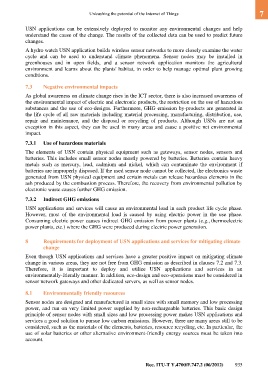Page 949 - Unleashing the potenti al of the Internet of Things
P. 949
Unleashing the potential of the Internet of Things 7
USN applications can be extensively deployed to monitor any environmental changes and help
understand the cause of the change. The results of the collected data can be used to predict future
changes.
A hydro watch USN application builds wireless sensor networks to more closely examine the water
cycle and can be used to understand climate phenomena. Sensor nodes may be installed in
greenhouses and in open fields, and a sensor network application monitors the agricultural
environment and learns about the plants' habitat, in order to help manage optimal plant growing
conditions.
7.3 Negative environmental impacts
As global awareness on climate change rises in the ICT sector, there is also increased awareness of
the environmental impact of electric and electronic products, the restriction on the use of hazardous
substances and the use of eco-designs. Furthermore, GHG emission by-products are generated in
the life cycle of all raw materials including material processing, manufacturing, distribution, use,
repair and maintenance, and the disposal or recycling of products. Although USNs are not an
exception in this aspect, they can be used in many areas and cause a positive net environmental
impact.
7.3.1 Use of hazardous materials
The elements of USN contain physical equipment such as gateways, sensor nodes, sensors and
batteries. This includes small sensor nodes mostly powered by batteries. Batteries contain heavy
metals such as mercury, lead, cadmium and nickel, which can contaminate the environment if
batteries are improperly disposed. If the used sensor node cannot be collected, the electronics waste
generated from USN physical equipment and certain metals can release hazardous elements in the
ash produced by the combustion process. Therefore, the recovery from environmental pollution by
electronic waste causes further GHG emission.
7.3.2 Indirect GHG emissions
USN applications and services will cause an environmental load in each product life cycle phase.
However, most of the environmental load is caused by using electric power in the use phase.
Consuming electric power causes indirect GHG emission from power plants (e.g., thermoelectric
power plants, etc.) where the GHG were produced during electric power generation.
8 Requirements for deployment of USN applications and services for mitigating climate
change
Even though USN applications and services have a greater positive impact on mitigating climate
change in various areas, they are not free from GHG emission as described in clauses 7.2 and 7.3.
Therefore, it is important to deploy and utilize USN applications and services in an
environmentally-friendly manner. In addition, eco-design and eco-operations must be considered in
sensor network gateways and other dedicated servers, as well as sensor nodes.
8.1 Environmentally friendly resources
Sensor nodes are designed and manufactured in small sizes with small memory and low processing
power, and run on very limited power supplied by non-rechargeable batteries. This basic design
principle of sensor nodes with small sizes and low processing power makes USN applications and
services a good solution to pursue low carbon emissions. However, there are many areas still to be
considered, such as the materials of the elements, batteries, resource recycling, etc. In particular, the
use of solar batteries or other alternative environment-friendly energy sources must be taken into
account.
Rec. ITU-T Y.4700/F.747.2 (06/2012) 935

